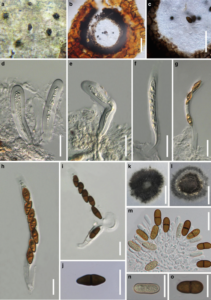Dothiorella vidmadera Pitt et al., Fungal Diversity 61: 216, 2013
Facesoffungi number: FoF 01326, Fig. 2
Saprobic on dead branch of Fraxinus ornus L. Sexual morph Ascostromata 320 – 410 μm diam., dark brown to black, globose, submerged in the substrate, partially erumpent at maturity, ostiolate. Ostiole circular, central, papillate. Peridium 50 – 80 μm thick, composed of dark brown thick-walled cells of textura angularis, becoming thin-walled and hyaline towards the inner region. Pseudoparaphyses 3 – 5 μm wide, thin-walled, hyaline. Asci 150 – 220 × 12 – 22μm, 8 – spored, bitunicate, cylindric-clavate, endotunica thick – walled, with a well-developed ocular chamber. Ascospores 17 – 26 × 8 – 10 μm (x̄ = 22 × 9 μm, n = 20), obliquely uniseriate or irregularly biseriate, initially hyaline and becoming dark brown, oblong to ovate, widest in center, straight, 1-septate, constricted at the septum, moderately thick-walled, surface smooth. Asexual morph Conidiomata 380 μm wide, globose, pycnidial, stromatic, solitary, composed of dark brown, thickwalled cells of textura angularis. Conidiogenous cells 8 – 14 × 3 – 6 μm, lining the pycnidial cavity, holoblastic, hyaline, subcylindrical. Conidia 17 – 22 × 9 – 10 μm (x̄ = 21 × 10 μm, n = 20) initially hyaline and aseptate, becoming pigmented brown and 1 – septate while attached to conidiogenous cell, slightly constricted at the septum, ovoid with a broadly rounded apex and truncate base.
Culture characteristics: Colonies on PDA, covering 20 mm diam. in Petri – dishes after 30 days in the dark at 25 °C; circular, initially white, after 1 week becoming greyish brown to black; reverse grey to dark greyish green; flattened, fluffy, fairly dense, aerial, surface smooth with crenate edge, filamentous and conidia produced on pine needles after 3 weeks at 18 °C.
Material examined: ITALY, Province of Forlì-Cesena [FC], Corniolo – Santa Sofia, on dead branch of Fraxinus ornus (Oleaceae), 6 December 2013, Erio Camporesi IT 1562 (MFLU 15–3483, reference specimen designated here), ex-type living cultures MFLUCC 15–0759, KUMCC 15–0129, GZCC 15–0007.
Notes: The sexual morph of Dothiorella vidmadera is morphologically similar to D. sarmentorumand D. Iberica in having globose ascostromata with a central ostiole, lined with hyaline cells, a wide peridium, bitunicate asci with a thickened endotunica, and dull brown or dark reddish brown, septate, ellipsoid – obovoid, ascospores, constricted at the septum. It however differs in spore dimensions and molecular phylogeny. The asexual morph of Dothiorella vidmadera was observed in culture and is similar to that described by Pitt et al. (2013b) and differs from the other asexual morphs of Dothiorella species (Phillips et al. 2013; Abdollahzadeh et al. 2014; Crous et al. 2015a). Our strains of D. vidmadera (MFLUCC 15–0759) clustered in the Dothiorella clade with 94 % bootstrap support (Fig. 1) and this is the first report of the sexual morph for Dothiorella other than D. sarmentorum and D. iberica.

Fig. 1 Phylogram generated from Maximum Parsimony analysis based on combined ITS and LSU sequence data of species of Botryosphaeriaceae. Parsimony bootstrap support values for MP ≥ 70 % are shown above the nodes and Bayesian posterior probabilities ≥95 % are indicated in bold branches. The tree is rooted.

Fig. 2 Dothiorella vidmadera (MFLU 15–3483, reference specimen) a Appearance of ascostromata on host substrate b Cross section of ascoma c Peridium d – f Immature asci g – i Mature asci j Mature brown ascospore k, l Culture on PDA m Immature and mature conidia attached to conidiogenous cells n Immature hyaline conidia o Mature conidia.
